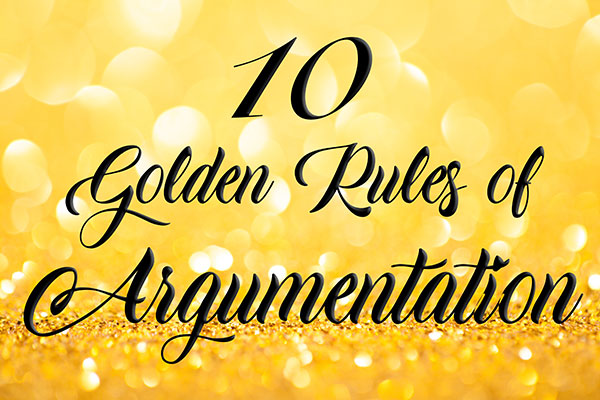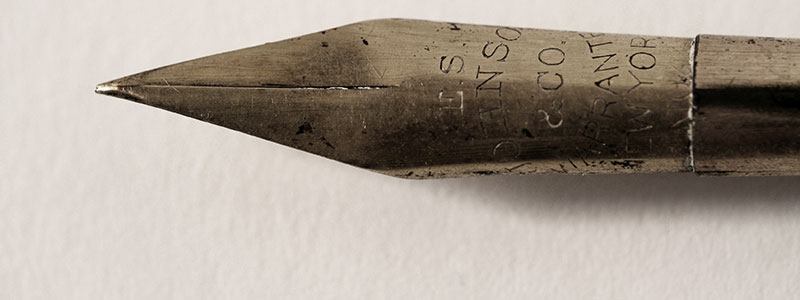
The Top 10 Golden Rules of Argumentation
”These rules will make you a better lawyer – whether arguing by zoom, in court, or in a settlement conference in the judge’s chambers.
My inbox and Twitter feed have been flooded with top ten lists. Most of the advice is redundant and commonsense (lift weights, read more, get more sleep, etc.), but some of it is truly helpful. So, I decided to create my own top ten list.
Increasingly, I realize the importance of effective argumentation. Few hearings these days, at least in my court, are evidentiary. More often they hinge on arguments, informal ones, like a settlement conference, or formal hearings resolving an issue. With that in mind, here’s my contribution to the top ten repertoire.
Peskind’s 10 Golden Rules of Argumentation
Remember to whom you are arguing. Too often, we flatter ourselves with our erudition and brilliance. But what really matters is impressing the person who will decide the issue: the judge. Clarence Darrow wasn’t Clarence Darrow because of self reverie; rather it was because his arguments appealed to those before whom he appeared. Give the judge concrete reasons to want to find in your client’s favor.
It’s critical that you know your judge. If your judge is more light-hearted, you might want to engage in some informal banter before getting to the heart of the issue. If the judge is more somber, a formal presentation is probably in order. Great salespeople understand the concept of rapport. Aren’t we salespeople after all? We just sell ideas instead of products. Increase the likelihood of making the sale by building rapport with your judge; focus on what they want to hear, rather than what you want to say.
Also, remember the judge’s goals are different from yours. What is the goal of most judges? To both follow the law, and resolve an issue fairly for both parties. Craft your arguments with this in mind. While occasionally a judge responds positively to fist-pounding, in my experience it rarely works. When you approach the issue instead with common sense and a problem-solving demeanor, a more satisfactory result usually follows.
As the son of a lawyer, the gravitas of the judicial system was instilled in me as a child. This gravitas has sadly eroded. Many lawyers today treat a court hearing like a mud wrestling match at the county fair. Get out of the mud. Be dignified during your presentations. Don’t interrupt your opponent or engage in ad hominems. As Marcus Aurelius observed, the best way to deal with assholes is not to be like them. Trust me, the judges will notice (and reward) good behavior.
We live with our cases for months and sometimes years. We internalize them and forget that the judge doesn’t know the facts as well as we do. Don’t just get up and start blabbing about how your client has been wronged. Give the judge a brass tacks context before starting your argument. First, start with what you are asking the judge to do, “Judge, we are here today seeking XYZ…..” Next, recite the relevant facts, ethically slanting them in your client’s favor. Finally, after these preliminaries are satisfied, argue the reasons WHY your “ask” is the correct result. To recap:
- What do you want,
- What facts support that relief, and
- Why it’s the right thing for the judge to do…in that order.
This practice serves two purposes. First, it helps you clarify what you are seeking. Seeing it in writing brings insights. You may determine it’s a hail mary that is unrealistic. I often clarify my thinking by writing it down; this exercise will help you do so as well. This practice also helps the judge. When you provide a proposed order at the beginning of your presentation, it’s like a playbill at the theater. The requested relief is clear and the judge can follow along as the argument unfolds. Also, when a busy judge has the order in front of him or her, there is the possibility that the judge will just sign it to move on to the next case.
As I mentioned above, we internalize our cases when we live with them for extended periods. As such, we tend to focus on the important facts impacting our issues, themes, and theories. Many mundane facts are overlooked as inconsequential. For example, the ages of the children or the date of the marriage. Being the more knowledgeable lawyer, however, adds credibility to both you and your arguments. The better-informed lawyer often walks out the winner. That being said, if you don’t know something, admit it rather than trying to bullshit your way through. An honest mea culpa also creates credibility.
Likewise, know the law. Are you proceeding under a particular statute? Reread it. Familiarity lulls us into false certainty. Because we have read the statute a million times, we’re certain of its terms. But our minds play tricks on us. I’ve often been startled by a helpful (or fatal) clause I’d overlooked. Also, stay current with the case law. Nothing is more humiliating than being jammed by some new decision of which you were unaware. I set aside an hour every Sunday morning to read new decisions. It’s a practice I commend to all.

Proper decorum demands that you address all arguments to the court. Don’t engage directly with your opponent. Judges hate this. (See Tip #8, below, about self-control). Don’t talk over your opponent either. Let them finish before you respond. Fear drives us to talk over or attack our adversary. Take a breath and keep it in check. While it seems obvious, don’t argue with the judge either. Do you really think you are going to win that argument? Such a confrontation usually results from a lack of control or frustration. Don’t do it. Generally, when I find myself fighting the impulse to engage the judge, it’s a pretty good indicator that it’s time for a vacation! But, if you can respectfully point out that the judge has misapplied a fact or misapprehended the law, it’s fair to bring it to their attention to allow them an opportunity to change course.
Particularly when you have limited time, visual aids tell the story better than verbal presentations. Consider a timeline you can give to the judge illustrating important developments. Or prepare an affidavit for your client summarizing important facts. Increasingly our world is visual, and your presentations must be as well. Use these aids to better tell the story, and support your arguments.
What’s harder than not lashing out in the heat of battle? Anger and fear are forever present in the adversarial process, particularly when dealing with unscrupulous opponents. But regardless of the provocation, reactivity rarely benefits you or your client. More often it leads to disaster. Divorce lawyer extraordinaire, Jim McLaren, advises lawyers to learn the art of “taking the spear”. This means to remain unflappable and composed under fire. Self-control is truly a superpower. Strive to maintain it. By the way, many think anger is warranted when outrageous behavior is present. But when you’re angry the judge doesn’t need to be. Stay calm and lay out the facts persuasively to invoke the judge’s anger. Leave your own rage in the parking lot. I often define a win by how well I kept it together at a hearing rather than by the result.
Speaking of self-control, liars truly make me crazy. Today, more than ever, lawyers are shamelessly distorting the facts and law. What to do? First, be the master of your case facts and the law to neutralize the dissembling. Next, remember that you have no control over what comes out of their mouths but you do have control of what comes out of yours. Don’t be like them – tell the truth. Lying is unethical and ultimately fatal to your career. Use your energy to outthink them and plan your response. Angry reactivity dilutes your energy and brainpower.
Aristotle instructed that persuasive arguments require three elements: ethos, logos, and pathos. Logos and pathos are the logic and emotional tug of the argument. Those are crafted case by case. But ethos involves the credibility of the arguer. It transcends the present case. When judges mistrust you, the stain will follow you throughout your career. Be prepared and be honest – the gold standards for our profession.
Listen closely to the windy oratory of your opponent. What information is he or she revealing in the argument? Let them educate you about their theories and themes – helpful information, if not that day, for use later in the case. And listen to the judge as well, both with your eyes and your ears. What does the judge’s body language reveal about your theories? Is the judge eye-rolling or rapt? Is the judge patiently absorbing your presentation or restively looking away? If the latter is the case, it may be time to pull back (if still possible) and retool.
A friend of mine, who went on to become a billionaire real estate developer, was fond of the phrase, “Nobody ever got into trouble listening.” If the Judge is berating your opponent’s argument, keep your mouth shut and enjoy. For some reason, lawyers always feel they need to be adding to the discussion. Often the best thing to say is nothing!
Follow These Golden Rules of Argumentation
These 10 tips will make you a better lawyer – whether arguing by zoom, in court, or in a settlement conference in the judge’s chambers. Ultimately though, the single greatest superpower is to remember to keep perspective. Lawyers are famous for their large egos. But your client’s life isn’t your life. Disconnect. As the great trial lawyer David Boies stated, “what’s the worst thing that happens to me…I lose?” You’ll do a much better job for your client if you distance yourself from the dispute. Remember Kipling’s brilliant admonishment in his poem, If:
– Rudyard Kipling“If you can meet with triumph and disaster
And treat those two impostors just the same…”
It’s not about you or your win/loss record; that’s outside of your control. It’s about doing your best: prepare well, perform well, and stay professional. If you follow these golden rules, you will always succeed.
Visualization as a Tool to Enhance Performance: Picture Yourself in the Courtroom
“Be The Ball, Danny…”
—Caddyshack
Years ago I read an article about how professional golfers use visualization to enhance their performance. Why not trial lawyers?
In my book, One Hundred Days Before Trial: A Family Lawyers Guide to Preparation and Strategy, I explain how visualization can help trial lawyers plan their trial. In the book, I provide a visualization exercise that I often use. Sit quietly with pen and paper and think through your trial beginning to end. Watch it unfold in your mind's eye—from first sitting down at counsel table through your positive ruling at the end of the case. Visualize as much sensual detail as possible: What’s everybody wearing? How does the courtroom look and sound? Feel your stomach churning; see the judge peering down at you from the bench. Making it more real will enhance the experience.
Try Your Case in Your Mind First
Let your subconscious go to work for you. Imagine giving your opening statement and let your theme and initial grabber bubble up. See yourself describing the important evidence in the context of your theory and theme. Observe your opponent doing the same thing.
Visualize witness examinations. In your mind’s eye, watch your client take the stand and see the "conversation" unfold. Watch your client’s demeanor as he or she is cross-examined as well. Imagine the actual cross-examination to help you prepare ways to preemptively neutralize it.
Think about the exhibits. Choosing and using exhibits is the heavy lifting of trial work. Don’t be like a squirrel gathering every nut on the ground to store for the winter. Visualize the specific exhibits that will have an impact and help you tell your story.
See your opponent presenting his or her case. What’s their theory? You can usually anticipate your opponent's arguments from revelations made throughout the case in arguments and/or conferences with the court. Both consciously and unconsciously, their arguments have been percolating in your mind for months. Now, visualize your counter arguments. Also see yourself cross-examining the opposing party and the opposing expert. Let your subconscious help you see the soft spots in the opponent’s case.
Conclude by imagining your closing argument, packaging the story for maximum impact. See yourself delivering the argument in a strong and confident manner. Hear your opponent giving their argument as well. Visualize your rebuttal.
Finally, not unlike pro golfers seeing the ball going into the cup, visualize a positive ruling granting you the relief you are seeking for your client. Feel the exhilaration of a satisfying result.
Write It Down
Immediately after visualizing the case from beginning to end, write down notes, observations, thoughts, to do's, outlines, and any other information that you mined from your subconscious. Use a mind map to help you “see” the case on paper. Use this visualization exercise to help you both plan your evidence as well as the structure of your arguments.
You can use visualization during motion practice as well. See yourself arguing your motion prior to the actual event to help build your confidence and enhance preparation.
As a great 20th century trial lawyer Lloyd Paul Stryker observed, “imagination for the trial lawyer is as essential as for the novelist, the artist or the poet." Use your imagination as the building blocks of preparation and performance in any task you encounter.
Now be the ball and make a hole in one!
Great Lawyers Steal (and so should you!)
In his book, Decoding Greatness: How the Best in the World Reverse Engineer Success author Ron Friedman describes how Barack Obama used modeling to launch his career. It's an amazing story and I want to share it with you:
Less than a decade before seemingly coming out of nowhere to capture the United States presidency in 2008, Barack Obama was immersed in an uphill political battle in Chicago, doing everything he could to persuade voters to elect him to Congress. There was just one problem: he was a dreadful speaker. As a former law professor, he was accustomed to lecturing audiences, not engaging them, and had an off-putting habit of incorporating complex, academic ideas that sailed over voters’ heads. His speeches left them feeling cold. Obama’s campaign staff begged him to abandon the professorial jargon and ramp up the emotion. But Obama was obstinate, leading his consultant Ron Davis to snap, “Motherfucker, you ain’t goin’ anywhere. You ain’t gonna get elected dogcatcher. You’re full of yourself. You have to let the air out.” The pleas fell on deaf ears. Obama went on to get trounced that November, losing by an embarrassing margin of more than two to one. The race left him broke, marginalized, and rudderless. For a time, he considered leaving politics. Then an adviser suggested that he spend some time in Chicago’s churches, paying close attention to the way preachers get their message across and inspire their audience. By the time Obama declared his candidacy for the US Senate just a few years later, his speaking style was transformed. Instead of communicating in abstractions, he was now telling stories, quoting the Bible, and using repetition to drive home his points. But it was more than just his words; it was also the way he was delivering them. Obama had learned to speak loudly at some points and softly at others, to modulate his tone and subtly convey emotion, to emphasize important arguments with a calm, deliberate pause. By adapting techniques commonly used in churches and importing them into the political arena, Obama was able to evolve his speaking style and establish himself as a unique political force.
While you likely don’t aspire to be president, the fact that you are reading this post suggests your desire to professionally excel. Take a page out of President Obama’s playbook–find appropriate role models to help you get there.
Advocacy Models
Search for an advocacy role model to emulate. If, for example, you are more cerebral and you are fundamentally introverted (like me), you don’t want to model a flamboyant fist-pounding lion tamer of a lawyer. Rather identify someone that fits your personality. As a young lawyer I admired Gerry Spence, but his fringed jacket and folksy demeanor didn’t work for me. Later, as the O.J. trial made celebrities of the so-called dream team, I raptly watched the trial, studying the team members' advocacy styles. Later in my career, I watched interviews of plain speaking David Boies. I saw how a powerful conversational tone can be a deadly weapon of persuasion.
You are not limited to modeling celebrity lawyers of course. Find local top guns and deconstruct how they make arguments–what works and why it works. Or consider fictional role models. Atticus Finch's famous closing in To Kill a Mockingbird is a great example of how Harper Lee used Aristotle’s rhetoric to elevate Atticus’ argument on behalf of Tom Robinson.
Model Great Orators
Also like Obama, find models outside your profession. Listen to the great speeches of Churchill or Martin Luther King. Great oratory transcends, and is as effective in the pulpit or political arena as it is in the courtroom. I remember as a young lawyer watching a VHS cassette tape of JFK’s press conferences. I deconstructed his body language and effective use of wit and self-effacement to manage (if not rule) often hostile journalists. I was also inspired by Ronald Reagan's deft use of humor to disarm his opponents. Frankly, humor and wit is always more effective than bombast and snarkiness.
Today, you have abundant resources on YouTube and other platforms to watch great speakers. Dial into TED talks to find inspiration. Watch commencement speeches of people you admire. The resources are truly endless. Learn from the greats and incorporate what you learn into your own presentations.
Study Great Legal Writers
Like it or not, as lawyers, we are also writers. Most of us are insecure in that role. Most often our daily activities are more akin to gladiators in the Coliseum rather than scholars in the library. But that doesn't mean you can’t borrow the wisdom of the greats to develop exceptional skills as a legal writer. Read judicial opinions by renowned legal writers or briefs by appellate specialists. Deconstruct their language, structure and style to incorporate into your own legal writing. I keep a “Swipe file” of language or references I admire or discover during my reading. Also check out Point Made: How to Write Like the Nation’s Top Advocates by Ross Guberman for inspiration. As they say, “great artists steal…” So do great lawyers!
Read Biographies
Modeling does not just involve mimicking the greats, rather I would describe it as trying to internalize what made them great, whether in the courtroom or as human beings. In this regard, you are well advised to study the lives of great lawyers and their trials. I devour biographies of great lawyers, both from ancient and modern times, and always find inspiration: Cicero, Daniel Webster, and Clarence Darrow are some of my favorite role models. More recently, I have been nourished by examining the careers of David Boies and Louis Nizer. When you go through a challenging period, pick up a book about one the greats confronting their own challenges. It will help palliate your anxiety. All lawyers (and human beings) face challenges and it helps to see how others overcame them rather than getting dragged down the drain by them.
Emotional Role Models
The Roman Stoics suggested taking role models with you as you confront your day. Adopt this practice as a way to brace yourself for a particularly challenging day or activity. On days that I need to inspire myself to advocacy brilliance, I might use Clarence Darrow as my inspiration. I bring him (well, of course, not really) to court as co-counsel. Or if I have a day that I need to be patient with bratty lawyers, Mr. Lincoln might accompany me to inspire me to be wise and self-controlled. On days that I need to bolster my courage, U.S. Grant is my riding companion. This may sound silly, but it is a practice used by the ancient Stoics and others to adopt the traits of the greats to help guide you throughout your day.
Great Lawyers Steal
Whether it be as an advocate, orator, writer or otherwise, look to the the greats to guide you. They stood on the shoulders of the giants that came before them as well. Nobody develops in a vacuum. We all learn from others. Why not use the wisdom and skill of the greats in our profession, to help you achieve success in the practice or beyond. Steal your way to greatness. Who knows, maybe you too can be president someday!
About the author

Steven N.Peskind
Principal Attorney
To be successful, a lawyer must have insight into the whole human catastrophe and be able to effectively traverse the legal system. It is the intersection of these two disciplines that fascinate me. I have been a lifelong student of both human nature and the law, and have created this blog to help others following my path.

Book Reviews

Practice Hacks

Random Musings
